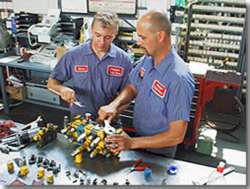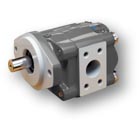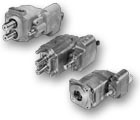
- Multiplication and variation of force: Linear or rotary force can be multiplied from a fraction of an ounce to several hundred tons of output.
- Easy, accurate control: You can start, stop, accelerate, decelerate, reverse or position large forces with great accuracy. Analog (infinitely variable) and digital (on/off) control are possible. Instantly reversible motion — within less than half a revolution — can be achieved.
- Multi-function control: A single hydraulic pump or air compressor can provide power and control for numerous machines or machine functions when combined with fluid power manifolds and valves.
- High horsepower, low weight ratio:Pneumatic components are compact and lightweight. You can hold a five horsepower hydraulic motor in the palm of your hand.
- Low speed torque: Unlike electric motors, air or hydraulic motors can produce large amounts of torque (twisting force) while operating at low speeds. Some hydraulic and air motors can even maintain torque at zero speed without overheating.
- Constant force or torque: This is a unique fluid power attribute.
- Safety in hazardous environments: Fluid power can be used in mines, chemical plants, near explosives and in paint applications because it is inherently spark-free and can tolerate high temperatures.
- Established standards and engineering: The fluid power industry has established design and performance standards for hydraulic and pneumatic products through NFPA, the National Fluid Power Association;ANSI, the American National Standards Institute;and ISO, the International Organization for Standardization.



